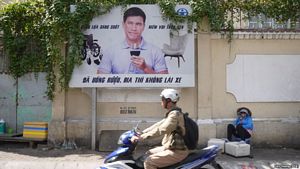|
By accessing or using The Crittenden Automotive Library™/CarsAndRacingStuff.com, you signify your agreement with the Terms of Use on our Legal Information page. Our Privacy Policy is also available there. |

Vietnam Pushes for More Educated Drivers to Curb Road Deaths
|
|---|
|
|
Vietnam Pushes for More Educated Drivers to Curb Road Deaths
Lien Hoang, VOA News
4 March 2015
 This billboard in Ho Chi Minh City tells drivers not to drink and drive, as part of a government campaign to cut down on the country’s high rate of traffic fatalities. This billboard in Ho Chi Minh City tells drivers not to drink and drive, as part of a government campaign to cut down on the country’s high rate of traffic fatalities.
|
HO CHI MINH CITY — On a recent weekday afternoon, two motorbike drivers headed toward each other on a small street in downtown Ho Chi Minh City. They didn’t see each other until it was too late and couldn’t get out of each other’s way. The collision sent one driver to the hospital and blocked off the road for many other drivers.
Truong Huynh Doan works at an electronics shop on that street. After surveying the wreckage, he returned to his store to gossip with a neighboring business owner about what happened and who was at fault.
Doan, 57, told Voice of America that the street is usually pretty safe, and when it comes to driving, so is he.
“I’ve been driving for decades and I haven’t had an accident,” he said, perched on a red plastic stool at the storefront. “You have to pay attention, you have to get used to how other people are driving.”
Not enough Vietnamese have Doan’s driving record. The Ministry of Transport warned on its website Feb. 22 that the number of fatal traffic accidents is rising in Vietnam. It said 246 people died from traffic accidents during the recent seven-day Tet holiday, compared with 214 during the new-year period in 2014.
Different factors contribute to the fatalities. But as with so many of the problems Vietnam faces, one major culprit is education. Some Vietnamese choose to skip the driver’s license altogether, so they never officially learn the rules of the road and they don’t use a turn signal or yield the right of way to another driver.
Even among those who do get licenses, many simply buy them or get the answers for the license examination, which is not a very challenging test to begin with.
“Internationally, 75 percent of the cause of accidents is the human factor, and the key thing is, the driver has to understand and follow the law,” Khuat Viet Hung, deputy chairman of Vietnam’s National Traffic Safety Committee, said in an interview.
He added, “The key thing is to have a good education and design the programs to improve the traffic awareness.”
On its website, the transport ministry said police will crack down on drivers who “run red lights, drive the wrong way down a street, break the speed limit, violate alcohol concentration rules, drive with more passengers than allowed, or fail to wear helmets.”
Doan, who is originally from the Mekong Delta province of Tien Giang, said these offenses are pervasive in the countryside. Education rates are lower in rural areas, so drivers are less likely to obtain licenses. And the wide open spaces encourage them to drive at higher speeds than they would in dense city centers.
As for Ho Chi Minh City, where he now lives, Doan sees fewer collisions these days and better road conduct. For example, drivers don’t hop onto sidewalks to circumvent gridlock as much as they did even five years ago.
Hung says that’s because the government has embarked on a multilateral strategy to reduce traffic accidents. Beginning last year, officials have focused on commercial transport, especially using technology to ease the burden on human resources.
“In our regulations, all commercial transport vehicles have to install the GPS monitoring device and all the information in the device is gathered,” Hung said.
That will allow officials to determine whether crashes are caused by speeding drivers working long hours, or other preventable behavior. The government is also looking into corruption in law enforcement, the quality of physical road conditions, and the use of traffic cameras.
These efforts have helped bring road fatalities down to 8,996 in 2014, compared with 11,500 in 2011, according to Hung.
“That is a significant improvement,” he said.

















 This billboard in Ho Chi Minh City tells drivers not to drink and drive, as part of a government campaign to cut down on the country’s high rate of traffic fatalities.
This billboard in Ho Chi Minh City tells drivers not to drink and drive, as part of a government campaign to cut down on the country’s high rate of traffic fatalities.
